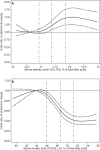Serum Fatty Acids, Desaturase Activities and Abdominal Obesity - A Population-Based Study of 60-Year Old Men and Women
- PMID: 28125662
- PMCID: PMC5270324
- DOI: 10.1371/journal.pone.0170684
Serum Fatty Acids, Desaturase Activities and Abdominal Obesity - A Population-Based Study of 60-Year Old Men and Women
Abstract
Abdominal obesity is a key contributor of metabolic disease. Recent trials suggest that dietary fat quality affects abdominal fat content, where palmitic acid and linoleic acid influence abdominal obesity differently, while effects of n-3 polyunsaturated fatty acids are less studied. Also, fatty acid desaturation may be altered in abdominal obesity. We aimed to investigate cross-sectional associations of serum fatty acids and desaturases with abdominal obesity prevalence in a population-based cohort study. Serum cholesteryl ester fatty acids composition was measured by gas chromatography in 60-year old men (n = 1883) and women (n = 2015). Cross-sectional associations of fatty acids with abdominal obesity prevalence and anthropometric measures (e.g., sagittal abdominal diameter) were evaluated in multivariable-adjusted logistic and linear regression models, respectively. Similar models were employed to investigate relations between desaturase activities (estimated by fatty acid ratios) and abdominal obesity. In logistic regression analyses, palmitic acid, stearoyl-CoA-desaturase and Δ6-desaturase indices were associated with abdominal obesity; multivariable-adjusted odds ratios (95% confidence intervals) for highest versus lowest quartiles were 1.45 (1.19-1.76), 4.06 (3.27-5.05), and 3.07 (2.51-3.75), respectively. Linoleic acid, α-linolenic acid, docohexaenoic acid, and Δ5-desaturase were inversely associated with abdominal obesity; multivariable-adjusted odds ratios (95% confidence intervals): 0.39 (0.32-0.48), 0.74 (0.61-0.89), 0.76 (0.62-0.93), and 0.40 (0.33-0.49), respectively. Eicosapentaenoic acid was not associated with abdominal obesity. Similar results were obtained from linear regression models evaluating associations with different anthropometric measures. Sex-specific and linear associations were mainly observed for n3-polyunsaturated fatty acids, while associations of the other exposures were generally non-linear and similar across sexes. In accordance with findings from short-term trials, abdominal obesity was more common among individuals with relatively high proportions of palmitic acid, whilst the contrary was true for linoleic acid. Further trials should examine the potential role of linoleic acid and its main dietary source, vegetable oils, in abdominal obesity prevention.
Conflict of interest statement
The authors have declared that no competing interests exist.
Figures

References
-
- Aune D, Greenwood DC, Chan DSM, Vieira R, Vieira AR, Navarro Rosenblatt DA, et al. Body mass index, abdominal fatness and pancreatic cancer risk: a systematic review and non-linear dose–response meta-analysis of prospective studies. Annals of Oncology. 2012;23(4):843–52. 10.1093/annonc/mdr398 - DOI - PubMed
MeSH terms
Substances
LinkOut - more resources
Full Text Sources
Other Literature Sources
Medical

